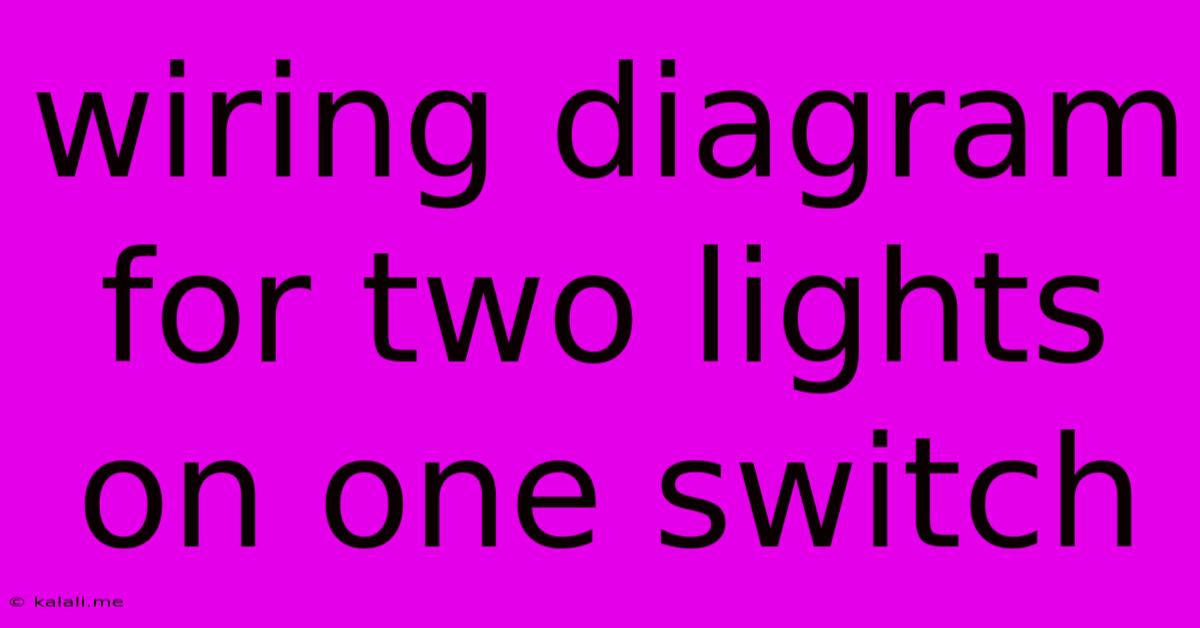Wiring Diagram For Two Lights On One Switch
Kalali
Jun 09, 2025 · 4 min read

Table of Contents
Wiring Diagram for Two Lights on One Switch: A Simple Guide
Meta Description: Learn how to wire two lights to a single switch safely and efficiently. This comprehensive guide provides clear diagrams and step-by-step instructions for both novice and experienced DIYers. We cover common wiring configurations and important safety precautions.
Are you looking to control two lights with a single switch? Whether you're updating your existing lighting or tackling a new installation, understanding the wiring process is crucial. This guide provides a clear and simple explanation of how to wire two lights to one switch, along with helpful diagrams to illustrate the process. We'll cover the necessary components, safety precautions, and step-by-step instructions to ensure a successful and safe installation.
Understanding the Basics: Parallel Wiring
The key to wiring two lights to a single switch lies in understanding parallel wiring. Unlike a series circuit where lights would need to work independently, a parallel circuit allows each light to operate independently. If one light fails, the other continues to function normally. This is the standard and safest method for home lighting.
This setup uses a single switch to control the power flow to both lights. When the switch is on, power flows to both lights simultaneously. When the switch is off, power is cut to both lights.
Components You'll Need:
- Switch: A single-pole, single-throw (SPST) switch is sufficient for controlling two lights from one location.
- Lights: Two light fixtures with appropriate sockets and bulbs.
- Wiring: Electrical cable (typically 14/2 or 12/2 gauge depending on your amperage requirements) with a ground wire. Always use the correct gauge wire for the amperage of your lights.
- Junction Box: A junction box to securely connect all the wires. This is crucial for safety and code compliance.
- Wire Nuts: Appropriately sized wire nuts for secure and safe wire connections.
- Voltage Tester: An essential tool for ensuring power is off before working with any electrical wiring.
Step-by-Step Wiring Instructions:
-
Turn Off the Power: This is the most important step. Turn off the power to the circuit at the breaker box before beginning any wiring. Use a voltage tester to double-check that the power is indeed off at the switch and light fixture locations.
-
Prepare the Wires: Carefully strip the insulation from the ends of the wires in your electrical cable, exposing enough wire to make secure connections within the junction box and switch.
-
Connecting at the Junction Box: This is where the "parallel" nature of the circuit becomes apparent.
- Hot Wire (Black): Connect the black (hot) wire from the power source to the black wire coming from the switch using a wire nut. Connect another black wire (from the cable going to one light fixture) to this wire nut as well. Finally, connect the black wire from the other light fixture to this same wire nut. All three black wires are now connected together to the single black wire coming from the switch.
- Neutral Wire (White): Connect all the white (neutral) wires from the power source, switch, and both light fixtures together using a separate wire nut.
- Ground Wire (Green or Bare Copper): Connect all the ground wires (green or bare copper) from the power source, switch, and both light fixtures using a third wire nut.
-
Connecting at the Switch:
- Hot Wire (Black): Connect the black wire from the power source (from the junction box) to one of the switch's terminals. The other terminal of the switch connects to the black wire running to the junction box (connecting to the lights).
- Neutral Wire (White): The white wire from the power source is connected directly to the white neutral wire in the junction box.
-
Connecting at the Light Fixtures: Connect the black (hot) and white (neutral) wires from the cable run to each light fixture to their corresponding wires inside the light fixture's junction box (which may be within the light fixture itself). Ensure the ground wire is also connected securely.
-
Secure and Test: Tuck all the wired connections neatly inside the junction boxes and secure the box covers. Turn the power back on at the breaker box and test both lights to ensure they work correctly.
Safety First:
- Always turn off the power before working with electrical wiring.
- Use the appropriate gauge wire for your lighting circuit's amperage.
- Never work with electrical wiring if you are not comfortable or familiar with the process. Consider hiring a qualified electrician.
- Inspect all connections regularly to ensure they remain secure.
This guide provides a general overview. Local building codes may vary, so always consult with your local authorities and ensure your work complies with all applicable regulations. If you're unsure about any aspect of this process, it's always best to consult a qualified electrician.
Latest Posts
Latest Posts
-
How Many 24 Oz In A Gallon
Jul 01, 2025
-
How Many Blades Of Grass Are There In The World
Jul 01, 2025
-
How Long Is Mayo Good For After Expiration Date
Jul 01, 2025
-
How Many Oz In A Lb Of Pasta
Jul 01, 2025
-
What Year Was I Born In If Im 19
Jul 01, 2025
Related Post
Thank you for visiting our website which covers about Wiring Diagram For Two Lights On One Switch . We hope the information provided has been useful to you. Feel free to contact us if you have any questions or need further assistance. See you next time and don't miss to bookmark.